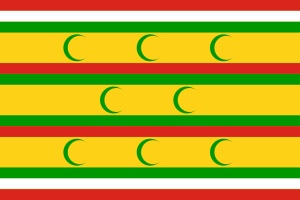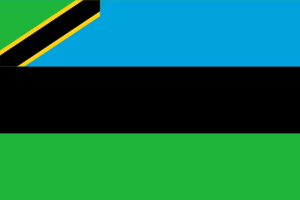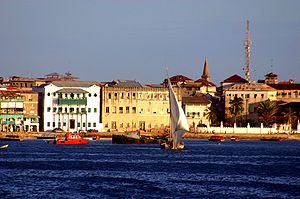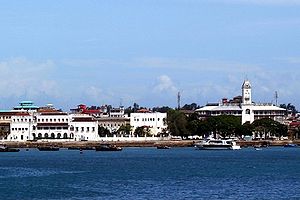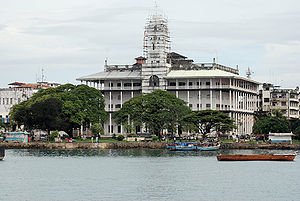Zanzibar
| Zanzibar | |||
|
|||
| Map of Zanzibar's main island | |||
| Zanzibar is part of Tanzania | |||
| Coordinates: 6°8′S 39°19′E | |||
|---|---|---|---|
| Country | Tanzania | ||
| Islands | Unguja and Pemba | ||
| Capital | Zanzibar City | ||
| Settled | AD 1000 | ||
| Government | |||
| - Type | semi-autonomous part of Tanzania | ||
| - President | Amani Abeid Karume | ||
| Area | |||
| - Total | 637 sq mi (1,651 km²) | ||
| Population (2004) | |||
| - Total | 1,070,000 | ||
Zanzibar is the name for an archipelago in the Indian Ocean 25–50 km off the coast of East Africa, of numerous small islands and two large ones: Unguja (the main island, sometimes informally referred to as 'Zanzibar'), and Pemba Island. The archipelago was once the separate state of Zanzibar, which united with Tanganyika to form Tanzania (derived from the two names), and still enjoys a high degree of autonomy within the union. The capital of Zanzibar, located on the island of Unguja, is Zanzibar City. The city's old quarter, known as Stone Town, is a World Heritage Site.
Zanzibar's main industries are spices (which include cloves, nutmeg, cinnamon and pepper), raffia, and tourism. Zanzibar is also the home of the endemic Zanzibar Red Colobus and the elusive Zanzibar Leopard. The word "Zanzibar" probably derives from the Persian زنگبار, Zangi-bar ("coast of the blacks") and it is also known as Zanji-bar in Arabic. "Zanzibar" may also refer to the spice ginger (genus Zingiber). Zanzibar is sometimes referred to as the "Spice Islands," a term that is also associated with the Maluku Islands in Indonesia. Pemba Island is the only island apart from Zanzibar that still produces cloves on a major basis which is the primary source of spice income for the islands.
Geography
The Zanzibar Archipelago consists of several islands lying off the coast of East Africa in the Indian Ocean: [1]
- Unguja Island, the largest, sometimes referred to as Zanzibar
- Pemba Island, the second largest
- Prison Island
- Bawe Island
- Chapwani Island
- Chumbe Island
- Mnemba Island
- Misali Island
In 1964 these islands joined with Tanganyika on the mainland to form the United Republic of Tanzania. Zanzibar island, the largest in the archipelago, covers 637 square miles (1,651 square km), while Pemba, the next largest, covers 350 square miles (906 square km).
These islands are believed to have once been part of the African continent, having separated during the Miocene (Pemba) and Pliocene (Zanzibar) epochs. The islands are formed from a base of limestone, which, through time, erosion, and earth movement, have formed a variety of soils such as clays, loams, red earths, and sands. Flat areas of coral limestone also occur. [2]
The island of Zanzibar is low-lying with small ridges along its central north–south axis. Masingini, the highest point of the central ridge system, is 390 feet (119 m) above sea level. The island's higher ground is slightly rolling, giving birth to several small rivers and streams. Believed to have once been covered by dense evergreen forest, what remains are small patches of indigenous forest and isolated large trees. Coconut palms, thicket vegetation and grass are abundant.
A tropical, humid climate lends to an annual average rainfall of 60 to 80 inches (1,500 to 2,000 mm), which is consistent and well-distributed throughout the islands. Northeast trade winds blow from December to March and southeast trade winds from May to October. Periods of “long rains” occur from March to May, while “short rains” fall October through December. [2]
Agreeable climate and fertile soil give rise to a variety of tropical crops, most importantly the export-crops of cloves and coconuts. Food grown for local consumption include rice, cassava, yams, and tropical fruit. The surrounding waters provide fish, also an important component of the native diet.
Fauna include the African pig, civet cat, forest duiker, lemur, leopard (a variety peculiar to Zanzibar), mongoose, two species of monkey, and pigmy antelope. Numerous species of bats and snakes exist. [2]
History
The first permanent residents of Zanzibar seem to have been the ancestors of the Hadimu and Tumbatu, who began arriving from the East African mainland around AD 1000. They had belonged to various mainland ethnic groups, and on Zanzibar they lived in small villages and did not coalesce to form larger political units. Because they lacked central organization, they were easily subjugated by outsiders.
Ancient pottery demonstrates existing trade routes with Zanzibar as far back as the ancient Assyrians.[citation needed] Traders from Arabia, the Persian Gulf region of modern-day Iran (especially Shiraz), and west India probably visited Zanzibar as early as the 1st century. They used the monsoon winds to sail across the Indian Ocean and landed at the sheltered harbor located on the site of present-day Zanzibar Town. Although the islands had few resources of interest to the traders, they offered a good point from which to make contact with the towns of the East African coast.
Traders from the Persian Gulf region began to settle in small numbers on Zanzibar in the late 11th or 12th century; they intermarried with the indigenous Africans and eventually a hereditary ruler (known as the Mwenyi Mkuu or Jumbe), emerged among the Hadimu. A similar ruler, called the Sheha, was set up among the Tumbatu. Neither ruler had much power, but they helped solidify the ethnic identity of their respective peoples.
Da Gama's visit in 1499 marks the beginning of European influence. The Portuguese established control over the island in 1503. In August 1505 it became part of the Portuguese Empire when captain John (João) Homere of de Almeida's fleet captured the island and claimed it for Portugal. It was to remain a possession of Portugal until 1698.
In 1698, Zanzibar became part of the overseas holdings of Oman, falling under the control of the Sultan of Oman. The Portuguese were expelled and slave traffic under the Sultan thrived along with an expanding economy in clove spice.
Sayyid Said bin Sultan al-Busaid moved his capital from Muscat in Oman to Stone Town in 1840. After his death in 1856, his sons struggled over the succession. On April 6, 1861, Zanzibar and Oman were divided into two separate principalities. Sayyid Majid bin Said Al-Busaid (1834/5–1870), his sixth son, became the Sultan of Zanzibar, while his brother, the third son Sayyid Thuwaini bin Said al-Said became the Sultan of Oman.
During this period, the Sultan of Zanzibar also controlled a substantial portion of the east African coast, known as Zanj, including Mombasa and Dar es Salaam, and trading routes extended much further into Africa, such as to Kindu on the Congo river. In November 1886, a German-British border commission established the Zanj as a ten-nautical mile (19 km) wide strip along the coast from Cape Delgado (now in Mozambique) to Kipini (now in Kenya) including all offshore islands and several towns in what is now Somalia. However, from 1887 to 1892, all of these mainland possessions were subsequently lost to the colonial powers of Britain, Germany, and Italy although some were not formally sold or ceded until the 20th century (Mogadishu to Italy in 1905 and Mombasa to Britain in 1963).
Zanzibar carries the distinction of having the first steam locomotive in East Africa, when Sultan Bargash bin Said ordered a tiny 0-4-0 tank engine to haul his regal carriage from town to his summer palace at Chukwani.
The British Empire gradually took over, and Zanzibar and the British position was formalized by the 1890 Helgoland-Zanzibar Treaty, in which Germany pledged not to interfere with British interests in insular Zanzibar. Zanzibar became a protectorate of the United Kingdom that year. The British appointed first Viziers from 1890 to 1913, and then British Residents from 1913 to 1963.
The death of Sultan Hamad bin Thuwaini on 25 August, 1896, saw the usurper Seyyid Khalid bin Bargash son of Sultan Bargash bin Said take over the palace and declare himself the new ruler. This was contrary to the wishes of the British Government, who favored Hamoud bin Mohammed. This led to a showdown, later called the Anglo-Zanzibar War, on the morning of 27 August when ships of the Royal Navy destroyed the Beit al Hukum palace having given Khalid an ultimatum to leave. He refused and at 9 am the ships opened fire and despite a substantial return fire from Khalid's rebel troops a cease fire was declared 45 minutes later after Khalid had fled to the German Consulate. The bombardment subsequently became known as The Shortest War in History. Hamoud was declared the new ruler and peace was restored once more[1]. Acquiescing to British demands, Hamoud brought an end to Zanzibar's role as a centre for the eastern slave trade that had begun under Omani rule in 17th Century by banning slavery and freeing the slaves of Zanzibar with compensation in 1897.
On December 10, 1963, Zanzibar received its independence from the United Kingdom as a constitutional monarchy under the Sultan. This state of affairs was short-lived, as the Sultan was overthrown on January 12, 1964, and on April 26 of that year Zanzibar merged with the mainland state of Tanganyika to form Tanzania, a part of which it remains to this day.
This period of transition was not without violence:
On January 12, 1964, a violent revolution ousted the ZNP-led coalition...More than 5,000 Arabs were killed, according to reports, and thousands of others were detained and their property either confiscated or destroyed. Yeager, Rodger (1989). Tanzania: An African Experiment.
The film Africa Addio also documented the massacre of Arabs which was led by a Christian Ugandan John Okello.
Political status
Although Zanzibar is part of Tanzania, it elects its own president who is head of government for matters internal to the island. Amani Abeid Karume was re-elected to that office on October 30 2005 under criticism from opposition candidate Seif Shariff Hamad [2]. Earlier, the fairness of his election on October 2000 was queried, and in January 2001 at least 27 protestors were killed by the police. [3]
Zanzibar also has its own Revolutionary Council and House of Representatives (with 50 seats, directly elected by universal suffrage to serve five-year terms) to make laws especially for it; these make up the semi-autonomous Revolutionary Government of Zanzibar.
The Island of Zanzibar comprises three administrative regions: Zanzibar Central/South, Zanzibar North and Zanzibar Urban/West. On the Island of Pemba are the two regions Pemba North and Pemba South.
Culture
Zanzibar is a conservative, Sunni Muslim society. Its history was influenced by the Arabs, Persians, Indians, Portuguese, British and the African mainland.
Stone Town is a place of winding lanes, circular towers, carved wooden doors, raised terraces and beautiful mosques. Important architectural features are the Livingstone house, the Guliani Bridge, and the House of Wonders. The town of Kidichi features the hammam (Persian baths), built by immigrants from Shiraz, Iran during the reign of Barghash bin Said.
Zanzibar was the first region in Africa to introduce color television, in 1973. The current TV station is called TvZ. The first television service on mainland Tanzania was not introduced until some twenty years later.
The southern and eastern portions of Zanzibar island have been mainly populated by a Bantu-speaking people known as the Hadimu; the northern portion of Zanzibar island and the adjacent Tumbatu island have been occupied by another Bantu-speaking people known as the Tumbatu. These two groups represent the earliest arrivals in Zanzibar. Throughout the 19th century, and after, they were expropriated from the western and more fertile parts of the island by later arrivals, notably Arabs. The nationalization of land in 1964, however, was followed by economic reforms that redistributed the land. Fishing has traditionally been highly important in coastal villages and remains so.
The language most widely spoken is a highly Arabicized form of Swahili (Kiswahili). Among the Arabs, the language of the home is usually Swahili, and use of pure Arabic is confined to scholars and recent arrivals from Arabia. Gujarati, Hindi, Urdu, and Konkani are spoken by the Asian communities, and English and Swahili are widely used and understood. [2]
Economy
Pemba Island was once the world's leading clove producer, although when the national government decided to privatize the clove market, the island went into an economic slump. Zanzibar exports spices, seaweed and fine raffia. It also has a large fishing and dugout canoe production. Tourism is a major foreign currency earner.
Before the development of eastern African mainland ports, Zanzibar was the trade focus of the region and enjoyed an important entrepôt trade. The island's economy now depends on agriculture and fishing.
Notes
ReferencesISBN links support NWE through referral fees
- Ruete, Emilie. 1989. Memoirs of an Arabian princess from Zanzibar. New York: M. Wiener Pub. ISBN 1558760075 and ISBN 9781558760073
- Newman, Henry Stanley. 1898. Banani: the transition from slavery to freedom in Zanzibar and Pemba. London [etc.]: Headley Bros.
- Fitzgerald, William Walter Augustine. 1970. Travels in the coastlands of British East Africa and the islands of Zanzibar and Pemba.
- Lyne, Robert Nunez. 1905. Zanzibar in contemporary times: a short history of the southern east in the nineteenth century. London: Darf. ISBN 1850771731 and ISBN 9781850771739
- Craster, John Evelyn Edmund. 1913. Pemba, the spice island of Zanzibar. London: T.F. Unwin.
- Uğur, Hatice. 2005. Osmanlı Afrikası'nda bir sultanlık: Zengibar. Küre Yayınları, 23. Aksaray, İstanbul: Küre Yayınları. ISBN 9756614242 and ISBN 9789756614242
External links
All links Retrieved April 21, 2008.
- Zanzibar Unveiled
- Map of Zanzibar and Tanganyika in 1886
- Joy as Zanzibar flies new flag
- Zanzibar
- Essential Zanzibar Guide
Credits
New World Encyclopedia writers and editors rewrote and completed the Wikipedia article in accordance with New World Encyclopedia standards. This article abides by terms of the Creative Commons CC-by-sa 3.0 License (CC-by-sa), which may be used and disseminated with proper attribution. Credit is due under the terms of this license that can reference both the New World Encyclopedia contributors and the selfless volunteer contributors of the Wikimedia Foundation. To cite this article click here for a list of acceptable citing formats.The history of earlier contributions by wikipedians is accessible to researchers here:
The history of this article since it was imported to New World Encyclopedia:
Note: Some restrictions may apply to use of individual images which are separately licensed.

